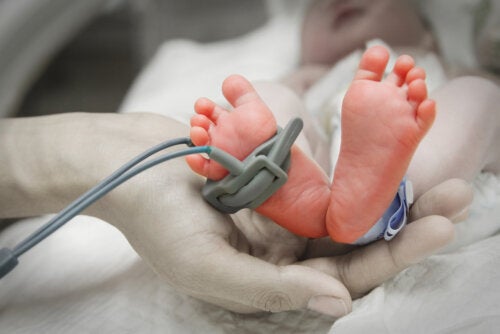Main Problems Facing Late Preterm Infants

Preterm births are becoming more and more frequent and most of them occur between 34 and 37 weeks of gestation. These babies are known as late preterm infants.
Despite advances in fetal and neonatal medicine, there are still many health problems that these babies face. For this reason, we want to tell you what they are and what special care should be given to these babies during the first months of life.
What does late preterm refer to?
Preterm birth is one that occurs before 37 weeks of gestation. Within this heterogeneous universe, babies born between 34.0 and 36.6 weeks are known as late preterm infants.
These children are not “near term” because they don’t behave as such. In fact, they have higher disease and mortality rates than children who complete maturity in the womb. This is basically because there’s no machine capable of matching what the womb offers during gestation. And in these last weeks of pregnancy, little ones finish preparing to survive in the outside world.

A trend that’s growing day by day
Unfortunately, the incidence of preterm births has increased in recent years worldwide. In Spain, for example, the overall rate of prematurity is around 7 % of deliveries, of which almost 70 % are late preterm.
Similarly, in the United States, the increase in preterm births was from 10.6 % in 1990 to 12.2 % in 2009. Mainly at the expense of late preterm births.
Some of the possible explanations for this phenomenon are the following:
- The increase and improvement of assisted reproduction techniques
- An increase in the rate of multiple pregnancies
- Increased incidence of induced labor
- Advanced maternal age
- An increase in the number of gestational complications, such as preeclampsia, obesity, gestational diabetes, among others
Although the last decade has evidenced a significant increase in preterm births, morbidity and mortality rates in newborns have also decreased. This is mainly due to the special care they receive in the Neonatal Intensive Care Units and the rigorous follow-up during the first years of life.
What are the risks for late preterm infants?
As mentioned above, late preterm infants are more prone to health problems after birth, due to the physiological and metabolic immaturity of their bodies.
In fact, hospital readmission rates for late preterm infants are higher than those for full-term infants. In general, the most frequent reasons are dehydration due to difficulties with breastfeeding, jaundice, poor weight gain, or respiratory problems.
This trend isn’t only observed in the first month of birth but extends throughout childhood. These infants are more prone to infections, respiratory disorders, and developmental difficulties.
Here are some of the most common health conditions of late preterm infants in the neonatal period and in infancy.
Alterations in temperature regulation
Preterm infants are more susceptible to hypothermia than full-term infants because they have less fatty tissue and lose heat more easily.
They also have an immature thermoregulatory brain function (hypothalamus) that helps to perpetuate this problem.

Respiratory distress
At 34 weeks gestation, the lung tissue isn’t fully mature and the amount of surfactant is still low.
The immaturity of this tissue predisposes late preterm infants to various pulmonary conditions, such as respiratory distress syndrome, transient tachypnea, or respiratory failure.
In addition, lower respiratory infections, such as pneumonia, can become recurrent in the first years of life. The younger the age, the greater the risk of developing bronchiolitis due to respiratory syncytial virus.
Hypoglycemia
Babies born at a lower gestational age have a higher risk of suffering a drop in glucose levels (hypoglycemia) in the first hours of life. This is related to a deficient metabolic response due to the immaturity of their body.
Apneas, bradycardia, and sudden death
Late preterm infants have a higher incidence of apneas (central and obstructive), as well as a decrease in their heart rate (bradycardia). Both conditions can increase the risk of developing sudden infant death syndrome.
Neurodevelopmental problems
Another problem faced by late preterm infants is delayed neurological development. In this regard, brain maturation intensifies from week 34 onwards. In fact, at 35 weeks, the fetal brain weighs only 65% of the brain of a full-term newborn and its external surface contains fewer sulci.
In the case of late preterm infants, much of the fetal neural development must take place outside the womb. And as we’ve mentioned, nothing in the world can match the conditions that the womb provides. Therefore, being born early predisposes children to the development of motor, cognitive, or behavioral problems.
For this reason, late preterm infants should have a strict pediatric follow-up during the first years in order to identify any neurological or other problems as soon as possible. In the pre-school and school years, these children may manifest some of the following conditions:
- Psychomotor deficits
- Problems in language development
- Attention deficit hyperactivity disorder (ADHD) and learning disabilities
- Behavioral disorders

Care that late preterm infants require
As we’ve said, late preterm infants have higher health risks and therefore, should receive special care after discharge from maternity.
Hospital readmission rates are 2 to 3 times higher in late preterm infants than in term newborns.
To avoid this outcome, different pediatric associations, such as the Spanish Society of Neonatology, suggest a series of care measures to guarantee the well-being of late preterm infants:
- Exclusive breastfeeding: Mother’s milk is the best food for babies, especially premature babies. The benefits it provides are key to their growth and development. However, it’s possible that there may be greater problems adapting to the breast, due to the baby’s immaturity.
- Skin-to-skin: The habit of maintaining skin-to-skin contact with the infant, as well as the kangaroo method, is very beneficial for late preterm infants. Physical contact, cuddling, and caressing promote body temperature regulation and bonding. And, in turn, they promote better physical and neurological development.
- Complementary feeding: Late preterm infants may have limitations in their growth and the diet should be supervised by the specialist. The initiation of complementary feeding should be based on their maturational status, corrected age, and motor development.
- Vaccination schedule: Late preterm infants should follow the same vaccination schedule as full-term infants, regardless of their gestational age and birth weight. Adequate compliance, without delays, is key to preventing morbidity and mortality due to these infectious diseases.
Late preterm infants require special follow-up
Certainly, most late preterm infants have a favorable evolution. However, they should be offered special follow-up during the first years of life, in order to prevent alterations or detect possible problems over time.
To achieve the best well-being of these children, the most important thing is the joint work between parents, caregivers, and health personnel involved.
All cited sources were thoroughly reviewed by our team to ensure their quality, reliability, currency, and validity. The bibliography of this article was considered reliable and of academic or scientific accuracy.
- Fernández, T. et al (2012). El prematuro tardío: el gran olvidado. Revista de Pediatría de Atención Primaria Vol.14 N°55 Madrid sep. 2012. Recuperado de: https://scielo.isciii.es/scielo.php?script=sci_arttext&pid=S1139-76322012000400013
- Islas, L. et al (2013). Prematuro tardío: morbilidad y mortalidad en la Unidad de Cuidados Intensivos Neonatales. Revista Médica del Hospital General de México. Vol. 76. Núm. 1. páginas 29-33 (Enero 2013). Recuperado de: https://www.elsevier.es/es-revista-revista-medica-del-hospital-general-325-articulo-prematuro-tardio-morbilidad-mortalidad-unidad-X018510631395620X
- Martin, Y. et al (2019). El prematuro tardío: evolución y recomendaciones de seguimiento. Pediatría Integral. Vol XXIII N° 3 abril-mayo 2019. Recuperado de: https://www.pediatriaintegral.es/publicacion-2019-05/el-prematuro-tardio-evolucion-y-recomendaciones-de-seguimiento/
- Sociedad Española de Neonatología SENeo (2017). Recomendaciones de seguimiento del prematuro tardío. Recuperado de: https://www.aepap.org/sites/default/files/documento/archivos-adjuntos/protocolo_prematuro_tardio.pdf